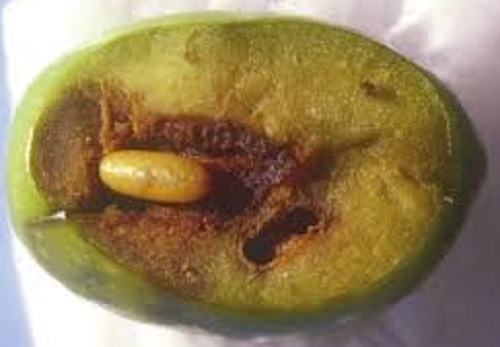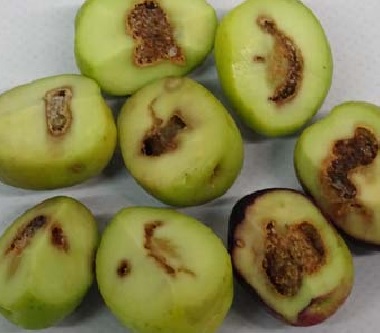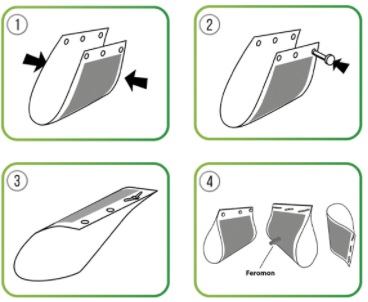Catalogue of traps and pheromones
Download traps and pheromones list

Download document
1.02 mb
The species is distributed in southern Western Europe, the Canary Islands, North Africa, and Asia. Pest of cultivated olives in the Mediterranean countries. During the year, it manages to change from 3 to 6 generations.

The impact of its attacks tends to worsen in the more humid and cooler growing areas, with significant variations depending on the variety grown, where it affects olive cultivars and areas that have hot summers and less drought.
The larva has a conical-cylindrical, narrow front. It develops through three stages (larva, first, second and third stage).
Egg-laying is done by making a puncture with the ovipositor into the skin of the olive, leaving only one egg in the hollow below. The bite has a characteristic triangular shape due to an optical effect. A puncture has a dark green colour, whilst older bites have a yellowish-brown colour as a result of wound healing.

Hatching occurs over a variable period depending on weather conditions: from 2–3 days in summer, to about 10 days in autumn. The newly hatched larva initially digs a tunnel on the surface, but later moves deeper into the flesh to the core, which is not affected in any way. During larval development, two changes occur, which in turn increase the size of the larva.

Around the third change, larvae at their third stage move toward the surface and prepare the exit hole for the adult, gnawing at the flesh to leave a thin surface layer. During this phase, the olive clearly shows signs of the attack because its appears darker in conjunction with the tunneling. On the surface, a circular hole due to the remaining residual skin becomes apparent. The pupae remain dormant in the hollow below, protected within the exuviae(the remains of an exoskeleton and related structures that are left after ecdysozoans have moulted) produced by the mature larvae.
At maturity, the adult breaks the exuvia and emerges from the pupa. It breaks the skin surface left by the larva by force and leaves the exit hole. In late autumn and winter, its behavior changes; the mature larva emerges from the olive and drops onto the ground, where pupation takes place.

The duration of young larva therefore varies from a minimum of 20 days to a maximum of 5 months in the overwintering generation.
The damages caused by the olive fruit fly are of two types: quantitative and qualitative.

From a quantitative point of view, the damage is caused by larvae of second and especially third stages, by the removal of the significant proportion of the pulp which as a consequence results in reduction in the yield of olives. Part of the production is also lost due to premature falling of the attacked fruit. Olive bites and holes dug by the larvae in the initial phase do not have a significant impact on the yield. In table olives, however, the damage extends to the sterile punctures, which cause the variation in production.

A qualitative aspect to be considered is the significant deterioration in the quality of the oil extracted from olives with a high percentage of attacks by larvae of the third stage. The oil obtained from infected olives has a high acidity level (expressed as oleic acid, from 2% to 10% depending on the percentage of the infestation) and a lower shelf life as it has a higher peroxide value.This deterioration in quality is evident in significantly flawed oils obtained from olives harvested from the ground or stored for several days before pressing.

Proper use of Pheromone Traps:
The pheromone trap is designed to monitor and reduce pest numbers. In order to determine the population density of pest insects and to identify pest outbreaks (monitoring), it is recommended to use 1 trap per 1 ha.
The trap should be placed as near the culture at the middle of the plant. Prior to the first flight of the flies, the traps must be checked on a daily basis, and after the first flieshave been captured, the traps must be checked every 5-7 days. Pheromone dispensers can be changed after 4-6 weeks and sticky tapes can be replaced when is full with pests and dust. Protective measures are based on the results of the monitoring of population density of pest insects.
Trap placement:
For mass capture and sterilization of males, it is recommended to have more than 20 traps per hectare in opened field. In case of a large number of pest insects use 30 traps per 1 ha in opened field. In greenhouses it is recommended to have more than 15 traps per hectare. In case of a large number of pest insects use 20 traps per 1 ha.


Download traps and pheromones list

1.02 mb
Review our catalogue of pheromons and semiochemicals by chemical name

525.1 kb